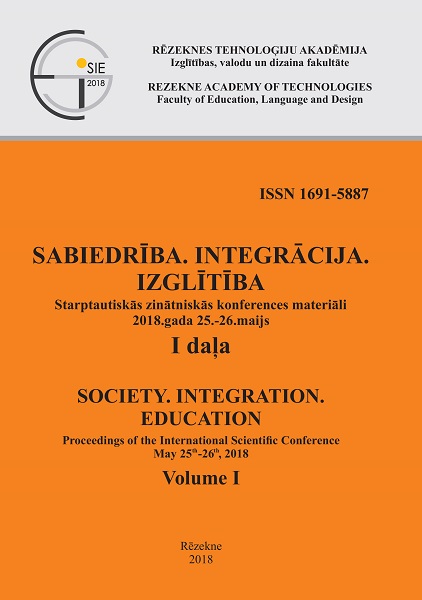THE KNOWLEDGE ON LYME BORRELIOSIS AND OTHER TICK-BORNE DISEASES AMONG NURSING STUDENTS FROM POLAND AND SLOVAKIA
DOI:
https://doi.org/10.17770/sie2018vol1.3275Keywords:
Lyme borreliosis, Poland, Slovakia, Students, Tick-borne diseasesAbstract
Tick-borne diseases are infectious diseases transmitted by the bites of infected ticks. The most common vector-borne disease in Europe is Lyme borreliosis (LB). The number of the reported cases of LB has been steadily increasing. For this reason, it is important to undertake educational activities in the field of tick-borne diseases. The aim of the study was to investigate the level and scope of knowledge on tick-borne diseases among nursing students from Poland and Slovakia. The study sample consisted of 428 nursing students (192 students of the State School of Higher Education in Biała Podlaska, Poland and 236 students of the University in Presov, Slovakia). The knowledge of the surveyed students on tick-borne diseases is limited. Polish students demonstrated greater knowledge about LB, while students from Slovakia showed greater awareness of the threat posed by tick-borne encephalitis. Particularly worrying is the lack of knowledge on proper way of removal of a tick attached to the skin. Students recognize the need to broaden their knowledge on tick-borne diseases, which should be taken into consideration in realized studies curricula.
References
Bartosik, K., Sitarz M., Szymańska J. & Buczek A. (2011). Tick bites on humans in the agricultural and recreational areas in South-Eastern Poland. Ann Agric Environ Med. 18, 151–157.
Cook, M. J. (2015). Lyme borreliosis: a review of data on transmission time after tick attachment. Int J Gen Med. 8, 1–8.
de la Fuente, J., Estrada-Pena, A., Venzal, J. M., Kocan, K. M. & Sonenshine, D. E. 2008. Overview: Ticks as vectors of pathogens that cause disease in humans and animals. Front Biosci. 1(13), 6938-6946.
Epidemiological Information System in Slovakia. Downloaded from http://www.epis.sk/InformacnaCast/Publikacie/VyrocneSpravy.aspx.
Kiewra, D. (2014). Evaluation of the vector role of ticks Ixodes ricinus L. 1758 (Acari, Ixodidae) in the transmission of Borrelia burgdorferi s.l. in Poland, with a particular focus on the Lower Silesia. Wrocław.
Kowalczyk, A., Kozłowska, E., Pacian, A. & Skórzyńska, H. (2015). Student’s awareness about appearance and feeding of ticks in Poland. Journal of Education, Health and Sport. 5(9), 469-480.
Kowalczyk, A., Kozłowska, E., Pacian, A. & Skórzyńska, H. (2016). Evaluation of students´ knowledge about Lyme disease and other tick-borne diseases. Hygeia Public Health. 51(2), 171-178.
Kurnatowski, P., Warpechowska, M. & Kurnatowska, A. J. (2011). Knowledge on Lyme disease among foresters. Int J Occup Med Environ Health. 24(1), 78-93.
National Institute of Public Health - National Institute of Hygiene (2016). Infectious diseases and poisonings in Poland in 2015, Warsaw. Downloaded from http://wwwold.pzh.gov.pl/oldpage/epimeld/2015/Ch_2015.pdf
Nejezchlebova, H., Kiewra, D., Žákovská, A. & Ovesná, P. (2016). Students' attitudes to tick risks. Ann Agric Environ Med. 23(3), 437-441.
Pancewicz S. A. (2014). Lyme disease – principles of diagnosis and treatment. Pediatr Med Rodz. 10(2), 163-173.
Pancewicz, S. A., Garlicki, A. M., Moniuszko-Malinowska, A., Zajkowska, J., Kondrusik, M., Grygorczuk, S., Czupryna, P. & Dunaj, J. (2015). Diagnosis and treatment of tick-borne diseases recommendations of The Polish Society of Epidemiology and Infectious Diseases. Przegl Epidemiol. 69(2), 309-316.
Rizzoli, A., Hauffe, H. C., Carpi, G., Vourc’h, G. I., Neteler, M. & Rosŕ R. (2011). Lyme borreliosis in Europe. Eurosurveillance, 16(27), 2-9.
Rizzoli, A., Silaghi, C., Obiegala, A., Rudolf, I., Hubálek, Z., Földvári. G., Plantard. O., Vayssier-Taussat, M., Bonnet, S., Špitalská, E. & Kazimírová, M. (2014). Ixodes ricinus and its transmitted pathogens in urban and peri-urban areas in Europe: new hazards and relevance for public health. Front Public Health. 1(2), 251.
Stanek, G., Wormser, G. P., Gray, J. & Strle F. (2012). Lyme borreliosis. Lancet, 379, 461-473.
Steere, A. C., Coburn, J. & Glickstein, L. (2004). The emergence of Lyme disease. The Journal of Clinical Investigation. 113(8), 1093-1101.
Tokarska-Rodak, M. (2016). Infections caused by Borrelia burgdorferi sensu lato. Health Problems of Civilization, 10(2), 5-9.
Tylewska-Wierzbanowska, S. & Chmielewski, T. (2017). Tick-borne bacterial diseases in Poland. Health Problems of Civilization, 11(2), 56-65.
Wójcik-Fatla, A., Szymańska, J. & Buczek, A. (2009). Tick-transmitted diseases. Part I. Ixodes ricinus as a reservoir and vector for pathogens. Pol J Public Health. 119(2), 213–216.
Zajkowska J. (2008). Lyme borreliosis - guidelines of treatment and expectations of patients. Przegl Epidemiol. 62(supl. 1), 142-151.






